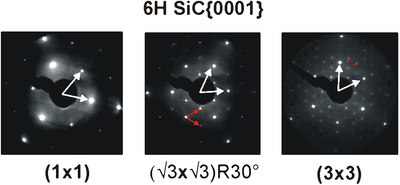Superstructure
In metallurgy and surface physics and chemistry, superstructure describes a unit cell that is larger than the one that would be obtained by (mentally) cutting through the crystal lattice of the volume . When characterizing surfaces, only the directions parallel to the surface are important because the arrangement of the atoms in the direction perpendicular to the surface is not periodic.
In the case of pure surfaces, superstructures can occur through surface reconstructions; however, adsorbate atoms or molecules can also form an ordered lattice on a surface, the unit cell of which is larger than that of the surface below.
designation
The description of the superstructure lattice is based on the crystal lattice of the cut volume lattice (basic lattice). In the following it is assumed that the unit cell of this lattice is described by the base vectors and ; the basis vectors of the superstructure cell are denoted here by and . The specification of a superstructure cell only indicates the size of the cell and its orientation in relation to the basic lattice (substrate), but does not say anything about the arrangement of the atoms in the cell.
Wood notation
In this notation, the basic vectors of the superstructure cell are given as multiples of the basic vectors of the basic lattice; In addition, the letter R ( rotated ) and an angle of rotation for the cell as a whole (compared to the basic grid) can be specified. An imagined point p or c is primitive or centered (engl. Centered ), "centered" means that the center of the cell is equivalent to the corner points. The letter p for a primitive unit cell can also be omitted and is normally only used if there was a centered cell of the same size.
Examples:
- is the periodicity of the basic lattice (i.e. no superstructure).
- means that the superstructure cell in the x-direction is twice as large as the cell of the basic lattice; the other lattice vector is the same for the basic lattice and the superstructure.
- describes a cell in the square lattice whose base vectors are the diagonals of the basic lattice. This superstructure can also be described as
Not all superstructure cells can be represented with Wood's notation. If the superstructure cell cannot be chosen so that the angle between its basis vectors and those of the basic lattice is the same, the matrix notation must be used.
Matrix notation
In matrix notation, the relationship between the basic vectors of the superstructure, and , and those of the basic structure is described by a matrix m:
A superstructure is created by the matrix
described.
Experimental determination

When imaging surfaces directly with the scanning tunneling microscope , superstructures can often be made directly visible. In contrast, with diffraction methods such as the diffraction of low-energy electrons (LEED), the reciprocal lattice of the surface is imaged. Since superstructure cells are larger than the unit cell of the basic lattice, the reciprocal lattice of a superstructure has a smaller basic cell than the basic lattice. This means that the superstructure leads to additional lattice points in the reciprocal lattice and thus to additional diffraction maxima.
On basic grids with 3, 4 and 6-fold axes of rotation , superstructures can appear in different rotational domains; For example, the same atomic arrangement can form a (2 × 1) structure on a square lattice or a (1 × 2) structure when rotated by 90 °. In this case, both structures are often found on one surface; each of the two structures forms small areas (domains). Non-mirror-symmetrical superstructure cells can also form mirror domains on mirror-symmetrical substrates. If several such domains are recorded at the same time in diffraction methods, the diffraction maxima overlap; in some of these cases the superstructure cell can no longer be derived directly from the diffraction image.
See also
Web links
- Examples of superstructures (English)
- Order and disorder (detailed lecture notes TU Dresden, of which chapter 15 is particularly relevant; PDF; 187 kB)











